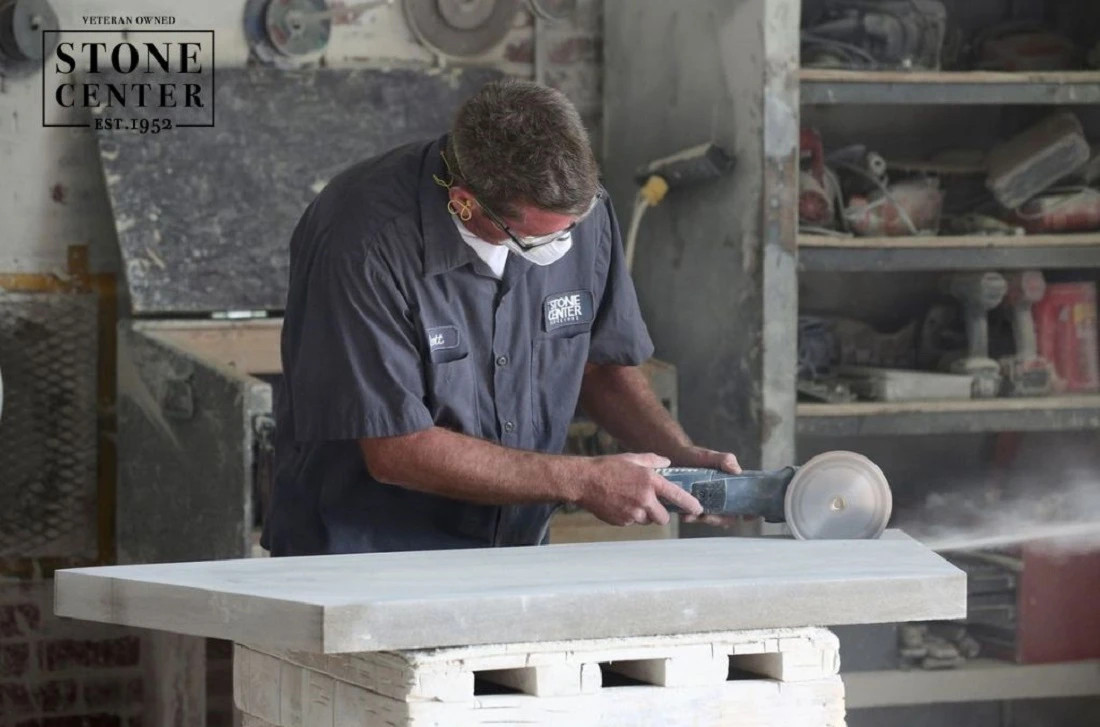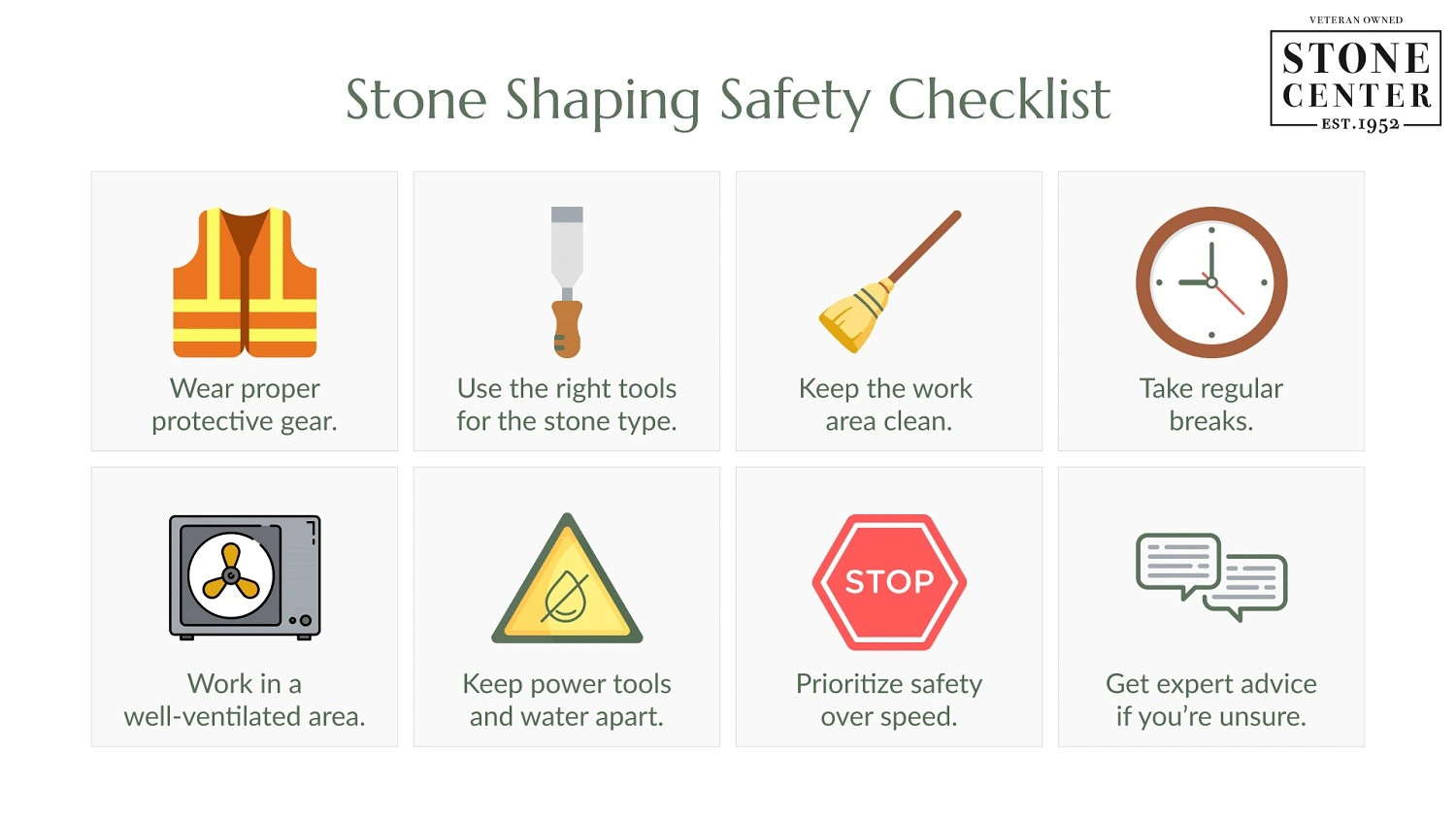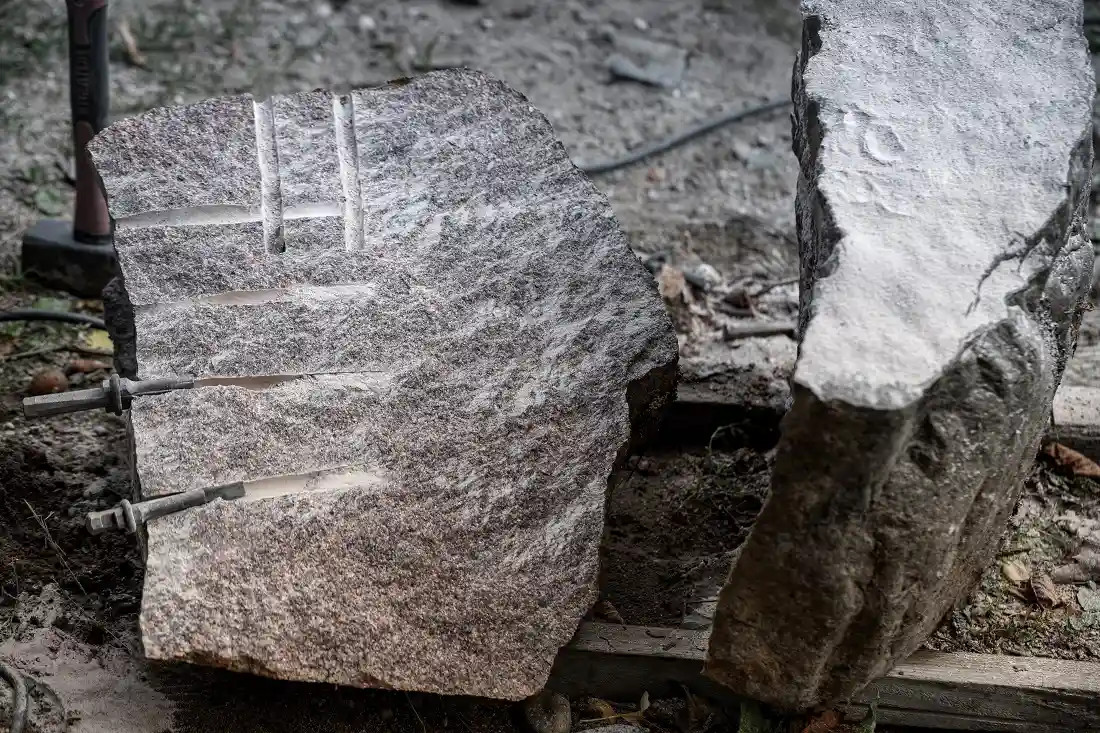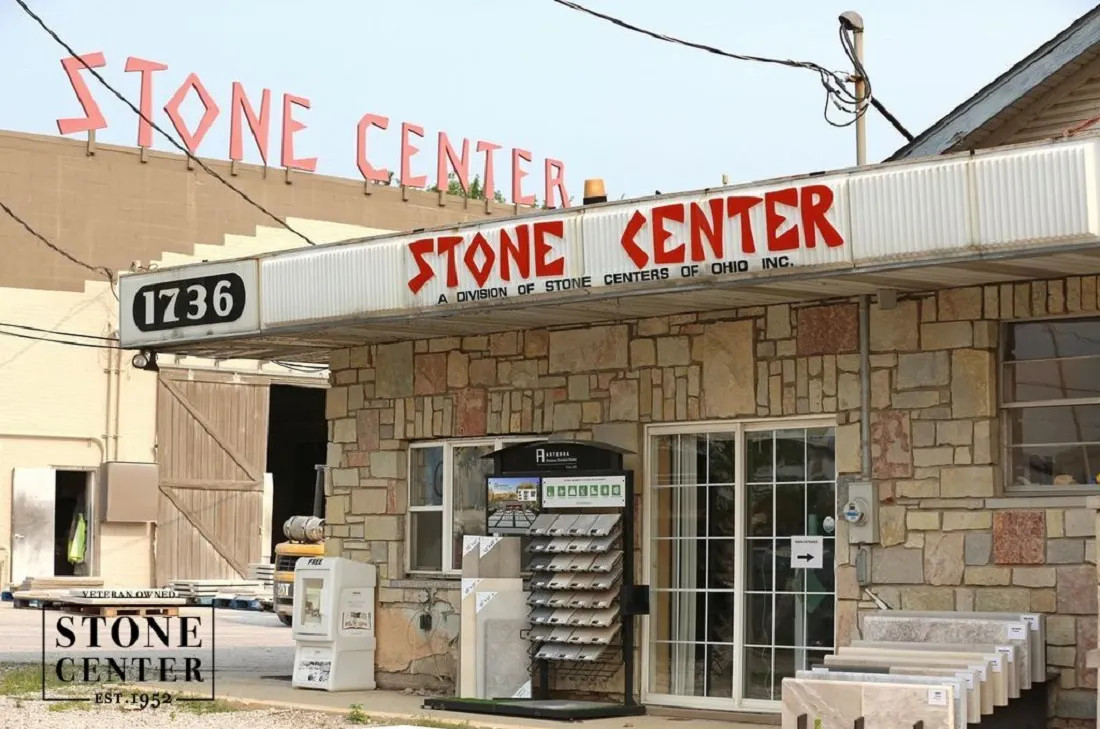Cutting rocks opens up a world of possibilities for landscaping and DIY projects. Can You Cut Rocks With An Angle Grinder? Yes, you can definitely cut rocks with an angle grinder, especially when fitted with the right diamond blade, making it a versatile tool for various stone-cutting tasks. Rockscapes.net provides expert advice and high-quality materials to bring your vision to life. This guide dives deep into using angle grinders, exploring techniques, safety measures, and alternative tools for achieving professional-looking results in your landscaping endeavors.
Table of Contents
1. Understanding Angle Grinders for Rock Cutting
- 1.1. What is an Angle Grinder?
- 1.2. Why Use an Angle Grinder for Rock Cutting?
- 1.3. The Right Blade: Diamond Blades Explained
2. Safety First: Preparing to Cut Rocks with an Angle Grinder - 2.1. Essential Safety Gear
- 2.2. Setting Up Your Work Area
- 2.3. Understanding Stone Types and Their Properties
3. Step-by-Step Guide to Cutting Rocks with an Angle Grinder - 3.1. Marking the Cut Line
- 3.2. Making the Initial Cut
- 3.3. Deepening the Cut
- 3.4. Completing the Cut
- 3.5. Refining the Cut Edges
4. Advanced Techniques and Tips - 4.1. Wet Cutting vs. Dry Cutting
- 4.2. Cutting Curves and Intricate Shapes
- 4.3. Minimizing Dust and Debris
5. Alternative Tools for Rock Cutting - 5.1. Tile Saws: Precision for Smaller Stones
- 5.2. Masonry Saws: Professional Power for Larger Projects
- 5.3. Rock Hammers and Chisels: Traditional Hand Tools
- 5.4. Feather and Wedge System: Splitting Large Stones
6. Choosing the Right Rocks for Your Project - 6.1. Types of Rocks and Their Characteristics
- 6.2. Sourcing Quality Rocks
7. Common Mistakes to Avoid - 7.1. Using the Wrong Blade
- 7.2. Applying Too Much Pressure
- 7.3. Neglecting Safety Precautions
8. The Role of Rockscapes.net in Your Landscaping Journey - 8.1. Inspiration and Design Ideas
- 8.2. High-Quality Materials
- 8.3. Expert Advice and Support
9. Maintaining Your Stone Work - 9.1. Cleaning and Sealing
- 9.2. Repairing Cracks and Chips
10. FAQ: Your Questions Answered About Cutting Rocks with an Angle Grinder
1. Understanding Angle Grinders for Rock Cutting
1.1. What is an Angle Grinder?
An angle grinder is a handheld power tool used for grinding, cutting, and polishing various materials. It consists of a motor that drives an abrasive disc at high speed. Angle grinders come in different sizes, typically ranging from 4.5 inches to 9 inches, referring to the diameter of the disc they use. Their versatility makes them indispensable for metalworking, construction, and, of course, rock cutting.
1.2. Why Use an Angle Grinder for Rock Cutting?
Angle grinders are popular for rock cutting due to their:
- Versatility: They can handle a wide range of rock types, from soft sandstone to hard granite.
- Portability: Their compact size allows for easy maneuverability and use in various locations.
- Cost-Effectiveness: Compared to specialized masonry saws, angle grinders are more affordable and readily available.
- Aggressiveness: Angle grinders are aggressive cutters and work best on smaller stones that you want to quickly shape.
1.3. The Right Blade: Diamond Blades Explained
The key to successfully cutting rocks with an angle grinder lies in using the right blade. Diamond blades are specifically designed for cutting hard materials like stone, tile, and concrete. These blades have diamond grit embedded in their cutting edge, providing exceptional durability and cutting power. According to research from Arizona State University’s School of Earth and Space Exploration, diamond-embedded tools provide superior cutting efficiency and longevity when working with geological materials.
Diamond blades come in two main types:
- Continuous Rim Blades: These blades have a solid, continuous rim of diamonds, ideal for smooth, chip-free cuts on materials like tile and softer stones.
- Segmented Rim Blades: These blades have gaps or segments in the rim, allowing for better cooling and debris removal, making them suitable for harder stones and faster cutting.
For rock cutting, a segmented rim diamond blade is generally recommended due to its ability to handle the abrasive nature of stone and provide efficient cutting.
 Angle Grinder with Diamond Blade
Angle Grinder with Diamond Blade
2. Safety First: Preparing to Cut Rocks with an Angle Grinder
Safety should always be your top priority when working with power tools. Rockscapes.net emphasizes the importance of following safety guidelines to prevent accidents and injuries.
2.1. Essential Safety Gear
Before you even think about turning on your angle grinder, make sure you have the following safety gear:
- Safety Glasses or Face Shield: Protect your eyes from flying debris.
- Dust Mask or Respirator: Stone cutting generates a lot of dust, which can be harmful to your lungs.
- Hearing Protection: Angle grinders can be quite loud, so wear earplugs or earmuffs to prevent hearing damage.
- Gloves: Protect your hands from cuts and abrasions.
- Work Boots: Provide foot protection and stability.
- Apron: A leather or heavy-duty apron will protect your clothing and body from sparks and debris.
2.2. Setting Up Your Work Area
A well-organized work area is crucial for safety and efficiency. Follow these guidelines:
- Choose a Stable Surface: Work on a sturdy workbench or sawhorses that can support the weight of the stone.
- Secure the Stone: Use clamps to hold the stone firmly in place. This prevents movement during cutting, which can lead to inaccurate cuts or accidents.
- Clear the Area: Remove any unnecessary items from your work area to avoid tripping hazards.
- Ventilation: Work in a well-ventilated area, especially if you’re dry cutting, to minimize dust inhalation.
2.3. Understanding Stone Types and Their Properties
Different types of rocks have varying hardness, density, and composition, which affect how they respond to cutting. Understanding these properties will help you choose the right cutting technique and blade. Here are some common rock types you might encounter:
- Sandstone: A sedimentary rock composed of sand grains cemented together. It’s relatively soft and easy to cut but can be abrasive to tools.
- Limestone: Another sedimentary rock, primarily composed of calcium carbonate. It’s softer than sandstone and tends to break along natural seams.
- Granite: An igneous rock known for its hardness and durability. It requires diamond blades for clean cuts.
- Slate: A metamorphic rock that splits easily along layers. It’s excellent for hand tools but can also be cut with power tools.
- Bluestone: A type of sandstone with a distinctive blue-gray color. It cuts cleanly with power tools and can also be split with hand methods.
- Travertine: A form of limestone characterized by its porous texture. It’s relatively soft but can chip easily, so wet cutting is recommended.
 Safety Tips for Stone Cutting
Safety Tips for Stone Cutting
3. Step-by-Step Guide to Cutting Rocks with an Angle Grinder
Now that you’re equipped with the right tools and safety gear, let’s dive into the actual cutting process.
3.1. Marking the Cut Line
Accurate cuts start with precise markings.
- Measure and Mark: Use a measuring tape and a marker to mark the desired cut line on the stone.
- Use a Straight Edge: For straight cuts, use a straight edge, such as a ruler or a level, to ensure the line is perfectly straight.
- Double-Check: Before you start cutting, double-check the measurements and the alignment of the cut line.
3.2. Making the Initial Cut
- Position the Blade: Align the diamond blade with the marked cut line.
- Start Slowly: Turn on the angle grinder and let the blade reach full speed before making contact with the stone.
- Shallow Cut: Start with a shallow cut, about 1/4 inch deep, along the marked line. This helps to establish the cut and prevent the blade from wandering.
3.3. Deepening the Cut
- Multiple Passes: Make multiple passes over the same cut line, gradually increasing the depth with each pass.
- Light Pressure: Apply light, consistent pressure to the angle grinder. Let the blade do the work, and avoid forcing it through the stone.
- Keep it Cool: If you’re dry cutting, take breaks to allow the blade to cool down. Overheating can damage the blade and reduce its lifespan. Wet cutting helps to keep the blade cool and minimize dust.
3.4. Completing the Cut
- Cut Through: Continue making passes until you’ve cut completely through the stone.
- Support the Stone: As you approach the end of the cut, support the stone to prevent it from breaking or chipping.
3.5. Refining the Cut Edges
- Smooth the Edges: Use the angle grinder with a diamond grinding wheel or a sanding disc to smooth the cut edges.
- Remove Sharp Edges: Pay attention to any sharp edges or splinters and remove them carefully.
4. Advanced Techniques and Tips
4.1. Wet Cutting vs. Dry Cutting
- Dry Cutting: Dry cutting is convenient and doesn’t require a water source. However, it generates a lot of dust, which can be a health hazard. Always wear a dust mask or respirator when dry cutting.
- Wet Cutting: Wet cutting involves using water to cool the blade and suppress dust. It provides cleaner cuts, reduces blade wear, and minimizes dust inhalation. You can use a garden hose or a specialized wet cutting attachment for your angle grinder.
According to the American Lung Association, silica dust from cutting stone can lead to serious respiratory illnesses, emphasizing the importance of dust control measures like wet cutting.
4.2. Cutting Curves and Intricate Shapes
While angle grinders are primarily designed for straight cuts, you can also use them to cut curves and intricate shapes with some practice and skill.
- Mark the Shape: Draw the desired shape on the stone.
- Multiple Cuts: Make a series of shallow, overlapping cuts along the curved line.
- Remove Excess Material: Use the angle grinder or other tools, such as a chisel or nippers, to remove the excess material.
- Refine the Shape: Use a grinding wheel or a sanding disc to refine the shape and smooth the edges.
4.3. Minimizing Dust and Debris
Stone cutting can create a significant amount of dust and debris. Here are some tips to minimize it:
- Wet Cutting: As mentioned earlier, wet cutting is an effective way to suppress dust.
- Dust Collection: Use a dust collection system or attach a vacuum to your angle grinder to capture dust at the source.
- Work Outdoors: If possible, work outdoors to allow dust to dissipate more easily.
- Protective Coverings: Cover nearby surfaces with plastic sheeting to protect them from dust and debris.
5. Alternative Tools for Rock Cutting
While angle grinders are versatile, other tools may be better suited for specific rock-cutting tasks.
5.1. Tile Saws: Precision for Smaller Stones
Tile saws are designed for making precise, clean cuts on smaller stones and tiles. They use a diamond blade and a water reservoir to keep the blade cool and minimize dust.
5.2. Masonry Saws: Professional Power for Larger Projects
Masonry saws are heavy-duty saws designed for cutting large stones, bricks, and concrete blocks. They offer more power and precision than angle grinders and are ideal for professional landscaping projects.
 Masonry Saw
Masonry Saw
5.3. Rock Hammers and Chisels: Traditional Hand Tools
Rock hammers and chisels are traditional hand tools used for shaping and splitting stones. They require more skill and effort than power tools but offer greater control and precision for certain tasks.
5.4. Feather and Wedge System: Splitting Large Stones
The feather and wedge system is a traditional method for splitting large stones into smaller pieces. It involves drilling holes in the stone and inserting feathers (shims) and wedges into the holes. By hammering the wedges, you can create a split along the desired line.
 Feather and Wedge System
Feather and Wedge System
6. Choosing the Right Rocks for Your Project
The type of rock you choose can significantly impact the aesthetic and structural integrity of your landscaping project.
6.1. Types of Rocks and Their Characteristics
- Granite: Known for its durability and resistance to weathering, granite is an excellent choice for load-bearing structures like retaining walls and steps.
- Limestone: With its earthy tones and smooth texture, limestone adds a touch of elegance to garden borders, walkways, and patios.
- Sandstone: Its natural cleft and warm colors make sandstone ideal for creating rustic pathways, walls, and decorative features.
- Slate: The distinct layered structure and dark hues of slate make it perfect for creating eye-catching garden accents, water features, and paving stones.
- Fieldstone: This is a general term for stones found on the surface of the ground, often used for walls and other rustic features.
6.2. Sourcing Quality Rocks
- Local Quarries: Sourcing rocks from local quarries ensures that they are well-suited to the regional climate and environment.
- Stone Suppliers: Stone suppliers offer a wide variety of rocks in different shapes, sizes, and colors.
- Rockscapes.net: Rockscapes.net provides high-quality natural stones sourced from trusted suppliers, ensuring that you get the best materials for your project.
 Stone Center in Ohio
Stone Center in Ohio
7. Common Mistakes to Avoid
7.1. Using the Wrong Blade
Using the wrong blade can damage the stone, the tool, or even cause injury. Always use a diamond blade specifically designed for cutting stone.
7.2. Applying Too Much Pressure
Forcing the blade through the stone can cause it to overheat, bend, or break. Let the blade do the work and apply light, consistent pressure.
7.3. Neglecting Safety Precautions
Failing to wear safety gear or follow safety guidelines can lead to serious injuries. Always prioritize safety when working with power tools.
8. The Role of Rockscapes.net in Your Landscaping Journey
8.1. Inspiration and Design Ideas
Rockscapes.net offers a wealth of inspiration and design ideas for incorporating rocks into your landscaping projects. Explore our gallery of stunning stone landscapes and get inspired to create your own unique outdoor space.
8.2. High-Quality Materials
We source our natural stones from trusted suppliers, ensuring that you get the best quality materials for your project.
8.3. Expert Advice and Support
Our team of experienced stone professionals is here to provide expert advice and support every step of the way. Whether you need help choosing the right rocks, selecting the appropriate tools, or planning your project, we’re here to assist you. Contact us at Address: 1151 S Forest Ave, Tempe, AZ 85281, United States. Phone: +1 (480) 965-9011. Website: rockscapes.net.
9. Maintaining Your Stone Work
Proper maintenance will help to keep your stone work looking its best for years to come.
9.1. Cleaning and Sealing
- Cleaning: Regularly clean your stone work with a mild detergent and water to remove dirt, debris, and algae.
- Sealing: Apply a stone sealer to protect the stone from stains, moisture, and weathering.
9.2. Repairing Cracks and Chips
- Small Cracks: Fill small cracks with a stone repair epoxy.
- Large Chips: Replace large chips with new stones or repair them with a stone patching compound.
10. FAQ: Your Questions Answered About Cutting Rocks with an Angle Grinder
- Can I cut granite with an angle grinder?
- Yes, you can cut granite with an angle grinder, but you’ll need a high-quality diamond blade designed for cutting hard stones. It’s also recommended to use wet cutting to keep the blade cool and minimize dust.
- What safety gear do I need when cutting rocks with an angle grinder?
- Essential safety gear includes safety glasses or a face shield, a dust mask or respirator, hearing protection, gloves, work boots, and an apron.
- Is it better to wet cut or dry cut rocks with an angle grinder?
- Wet cutting is generally better because it keeps the blade cool, minimizes dust, and provides cleaner cuts. However, dry cutting can be done safely with proper ventilation and a dust mask.
- What type of diamond blade should I use for cutting rocks?
- A segmented rim diamond blade is generally recommended for rock cutting due to its ability to handle the abrasive nature of stone and provide efficient cutting.
- How do I prevent the angle grinder blade from overheating?
- Use wet cutting to keep the blade cool, take breaks to allow the blade to cool down, and avoid applying too much pressure.
- Can I cut curves and intricate shapes with an angle grinder?
- Yes, you can cut curves and intricate shapes with an angle grinder by making a series of shallow, overlapping cuts along the curved line.
- What are some alternative tools for rock cutting?
- Alternative tools include tile saws, masonry saws, rock hammers and chisels, and the feather and wedge system.
- How do I minimize dust when cutting rocks?
- Use wet cutting, a dust collection system, work outdoors, and cover nearby surfaces with protective coverings.
- What should I do if the angle grinder blade gets stuck in the stone?
- Turn off the angle grinder and let the blade come to a complete stop. Then, carefully remove the blade from the stone by wiggling it back and forth.
- How do I maintain my stone work to keep it looking its best?
- Regularly clean your stone work with a mild detergent and water, apply a stone sealer to protect it from stains and moisture, and repair any cracks or chips as soon as possible.
Ready to transform your outdoor space with stunning rock features? Visit Rockscapes.net today for expert advice, high-quality materials, and endless inspiration! Let us help you bring your vision to life and create a landscape that you’ll enjoy for years to come. Explore our site for design ideas, information on various rock types, and helpful construction tips. Don’t wait – start your rock landscaping journey with rockscapes.net now!
